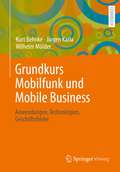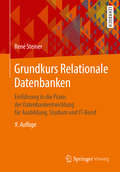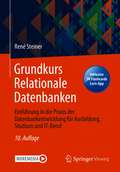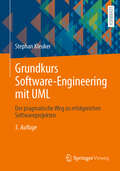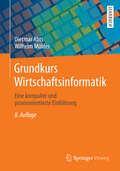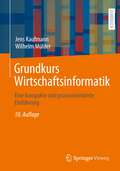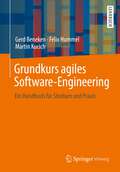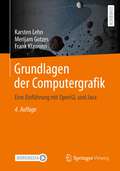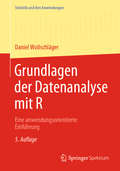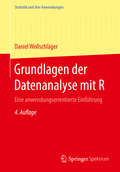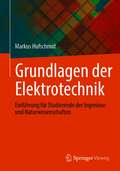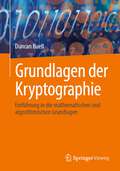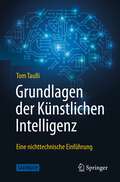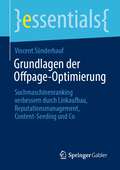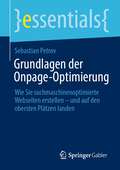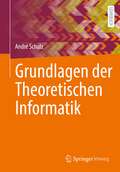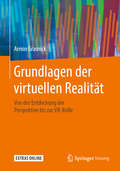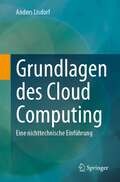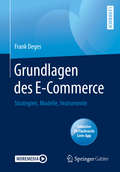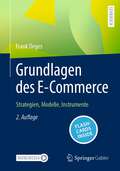- Table View
- List View
Grundkurs Mobilfunk und Mobile Business: Anwendungen, Technologien, Geschäftsfelder
by Wilhelm Mülder Kurt Behnke Jürgen KarlaDas Buch eignet sich für Leserinnen und Leser, die eine aktuelle und kompakte Darstellung von Mobile Business benötigen. Gut verständlich und mit vielen Beispielen werden die wichtigsten strategischen, anwendungsbezogenen und technologischen Fragen zur Nutzung von Smartphone, iPhone, iPad und Co. im Unternehmen behandelt. Das Buch richtet sich an Studierende der Wirtschaftswissenschaften, BWL, Wirtschaftsinformatik und Informatik. Es kann sowohl in Bachelor- als auch in Masterstudiengängen genutzt werden. Anhand zahlreicher Fragen und Aufgaben eignet es sich auch zur Klausurvorbereitung und zum Selbststudium.
Grundkurs Relationale Datenbanken
by René SteinerDieses Buch richtet sich an Studierende und IT-ler in Ausbildung und Beruf, die ohne unnötigen Theorieballast die Praxis der Entwicklung von Datenbankapplikationen erlernen möchten. Es ist als anwendungsorientiertes Lehrbuch aufgebaut und eignet sich für den Unterricht sowie zum Selbststudium. Praxisnah und verständlich werden die Themen Datenmodellierung, Datenbankentwicklung und Datenbankbetrieb vermittelt. Darüber hinaus ist eine Einführung in SQL enthalten. Der Leser erhält Zugang zu einem kostenlosen Online-Service, der das Buch ergänzt. Neu in der 9. Auflage sind Anwendungsfälle aus der Praxis im Bereich SQL und ein umfangreiches Fallbeispiel mit Übungsaufgaben.
Grundkurs Relationale Datenbanken: Einführung in die Praxis der Datenbankentwicklung für Ausbildung, Studium und IT-Beruf
by René SteinerDieses Buch richtet sich an Studierende und IT-ler in Ausbildung und Beruf, die ohne unnötigen Theorieballast die Praxis der Entwicklung von Datenbankapplikationen erlernen möchten. Es ist als anwendungsorientiertes Lehrbuch aufgebaut und eignet sich für den Unterricht sowie zum Selbststudium. Praxisnah und verständlich werden die Themen Datenmodellierung, Datenbankentwicklung und Datenbankbetrieb vermittelt. Darüber hinaus ist eine Einführung in SQL enthalten. Der Leser erhält Zugang zu einem kostenlosen Online-Service, der das Buch ergänzt. Neu in der 10. Auflage sind zusätzliche Fragen zum Buch in der Springer Nature Flashcards-App, die sich Leser kostenlos herunterladen können.
Grundkurs Software-Engineering mit UML: Der pragmatische Weg zu erfolgreichen Softwareprojekten
by Stephan KleukerMit der Entwicklung neuer Technologien werden auch die einzelnen Software-Projekte stetig komplexer. Zu analysieren, warum manche Projekte scheitern und andere erfolgreich sind, wird daher immer wichtiger. Dieses Buch ist ein praktischer Leitfaden für die Entwicklung neuer Software. Systematisch beschreibt der Autor die Chancen und Risiken, die einem bei der Entwicklung einer Software begegnen können. Vom gemeinsamen Kundengespräch, das Anforderungen und Ziele der Software festlegt, über die erste Modellierung bis hin zur systematischen Erfassung der Anforderungen zeigt er, wie die unterschiedlichen Prozesse mit Hilfe der UML (Unified Modeling Language) koordiniert werden können. Diese Modellierungssprache hilft, die Ideen des Entwicklers nachzuvollziehen und die Erfahrungen aus erfolgreichen Projekten auf andere Projekte zu übertragen. Neben Maßnahmen zur Qualitätssicherung beschreibt das Buch weitere Ansätze zur Projektplanung und Projektdurchführung und zeigt, wie die Softwareentwicklung in den Gesamtprozess eines Unternehmens eingebettet ist. Zum Verständnis des Buches werden Grundkenntnisse in einer objektorientierten Programmiersprache wie Java, C# oder C++ vorausgesetzt. Durch zahlreiche Wiederholungsfragen und Übungsaufgaben am Ende der Kapitel wird dieses Buch zum idealen Begleiter für Studierende der Informatik und verschiedener Ingenieurswissenschaften. Aber auch erfahrene Entwickler*innen können von den vielen Kommentaren zur Verwendung in der Praxis zur kontinuierlichen Weiterentwicklung des Software-Engineerings profitieren. Die vorliegende fünfte Auflage des bewährten Buches enthält erneut wichtige Erweiterungen, Aktualisierungen und Ergänzungen.
Grundkurs Wirtschaftsinformatik: Eine kompakte und praxisorientierte Einführung
by Dietmar Abts Wilhelm MülderMit unveränderter Dynamik etablieren sich neue IT- Anwendungsmöglichkeiten in unserer Gesellschaft. In Folge sind Unternehmen permanent gezwungen ihre bestehenden Informationssystem auf ihre Eignung, Aktualität und Wirtschaftlichkeit zu überprüfen. Daneben ermöglicht der technologische Fortschritt dabei auch immer wieder die Entwicklung völlig neuartiger IT-Systeme. Der „Grundkurs Wirtschaftsinformatik" beschreibt als Gesamtwerk der Wirtschaftsinformatik neben Hard- und Software-Lösungen auch deren praktische Anwendung und zeigt Wege in der Methodik und Organisation. Fallbeispiele, Übungsteile und Lösungen runden das Themenspektrum ab. Alle Kapitel wurden gründlich überarbeitet und didaktisch verbessert. Neu hinzu-gekommen sind Themen wie z.B. Software as a Service, Ruby on Rails, LTE, WiMAX, NoSQL-Datenbanken, Social Media, App-Stores und Green IT. Zwei neue Kapitel befassen sich ausführlich mit den aktuellen Trends „Mobile Business" und „Soziale Netzwerke". Durch zusätzliche Aufgabenund Wiederholungsfragen lässt sich das Buch noch besser als bisher zum Selbststudium und zu Klausurvorbereitung nutzen. Hinzu gekommen ist auch ein erweiterter Online-Service mit Klausuren und Musterlösungen.
Grundkurs Wirtschaftsinformatik: Eine kompakte und praxisorientierte Einführung
by Wilhelm Mülder Jens KaufmannIn diesem Lehrbuch erhalten Sie eine gut verständliche, praxisnahe Darstellung der gesamten Wirtschaftsinformatik. Dazu werden nach einer Einführung in die Grundbegriffe verschiedene digitale Geschäftsmodelle und ihre Umsetzung vorgestellt und es wird auf E-Business im Besonderen eingegangen. Im Bereich der Technologie werden Verfahren zur Datendarstellung und -verarbeitung erläutert und Hardware, Netzwerke und IT-Architekturen beschrieben. Die auf der Technologie basierenden Anwendungen umfassen Operative und Analytische Systeme sowie Datenbanken. Um Software zu entwickeln bzw. einzuführen, sind zudem Fragen der Organisation und Prozesse zu betrachten. Hierbei geht es um Projektmanagement, Software-Entwicklung und -Auswahl, IT-Management und IT-Sicherheitskonzepte. Praktische Anwendungsbeispiele, Fallstudien, Aufgaben und Musterlösungen erleichtern das Verständnis und ermöglichen Lernkontrolle bzw. Klausurvorbereitung.
Grundkurs agiles Software-Engineering: Ein Handbuch für Studium und Praxis
by Gerd Beneken Felix Hummel Martin KucichDas Buch richtet sich an Studierende und Berufseinsteiger*innen in der Software-Entwicklung. Sie sollten schon erste Erfahrungen im Programmieren und im Software-Engineering haben. Das Handbuch unterstützt sie bei der Durchführung von Entwicklungsprojekten im Team mithilfe agiler Methoden. Wir starten beim Teamaufbau und den ersten Gesprächen mit dem Auftraggeber. Wir erarbeiten die Bedürfnisse unserer Benutzer*innen und entwerfen damit ein minimales erstes Produkt, das MVP. Klassische Softskills betonen wir besonders: Selbstorganisation, Organisation von Meetings und Workshops sowie die Kommunikation mit dem Auftraggeber. Zusätzlich liefern wir ihnen einen Werkzeugkasten, dazu gehören die Verwendung einer Versionsverwaltung, die Techniken der Anforderungsanalyse, das Domain Driven Design sowie die Gestaltung von Benutzerschnittstellen. Das praktische Vorgehen in der Software Architektur, der Programmierung und dem Testen wird dargestellt. Den Abschluss bildet ein Kapitel über den IT-Betrieb und DevOps. Die praktischen Beispiele illustrieren wir mit git, gitlab, docker sowie Programmierbeispielen in Java. Der InhaltAgiles Software-Engineering: XP, Scrum und Kanban sowie DevOps und Lean StartupGrundlagen: Beginne bei Dir, Euer Team, Euer Produkt, Euer Projekt, Agile VerträgeSoftskills: Effektive Kommunikation, -Meetings, -Workshops, -Präsentationen und verständliche DokumenteWerkzeugkasten: Versionsverwaltung und Konfigurationsmanagement, Anforderungen, Benutzerschnittstellen, Architektur, Programmierung, Test, IT-Betrieb und DevOps
Grundlagen der Anforderungsanalyse: Standardkonformes Requirements Engineering
by Andrea HerrmannDieses Buch zeigt ein systematisches, mit aktuellen Standards konformes Vorgehen für die gesamte Anforderungsanalyse bzw. das Requirements Engineering. Dieses Vorgehen wird durch konkrete Beispiele und zwei durchgängige, nicht zu einfache Fallstudien illustriert: das Buchportal und das Fitness-Armband. Die verwendeten Vorlagen sowie agilen und nichtagilen Techniken haben sich in der Praxis bewährt. So können Sie heute schon anfangen, diese Techniken anzuwenden!
Grundlagen der Computergrafik: Eine Einführung mit OpenGL und Java
by Frank Klawonn Karsten Lehn Merijam GotzesComputergrafik umfasst die Erzeugung und Darstellung von einfachen Grafikelementen und Bildern bis hin zur Virtual Reality. Die Anwendung dieser Techniken profitiert von einem soliden Verständnis der entsprechenden Grundlagen. Das erfolgreiche Buch von Prof. Klawonn, das jetzt bereits in der dritten Auflage vorliegt, vermittelt genau das - verständlich und nachvollziehbar. Prof. Klawonn erläutert die wesentlichen Konzepte an konkreten Beispielen und bedient sich dabei der einfachen Sprachmittel der Javaprogrammierung. Die Umsetzung erfolgt praktisch mit Java 2D und Java 3D. Auch zur dritten Auflage gibt es wieder einen umfangreichen Online-Service mit Beispielprogrammen, Aufgaben und Lösungen, Folien und farbigen Illustrationen.
Grundlagen der Datenanalyse mit R: Eine anwendungsorientierte Einführung (Statistik und ihre Anwendungen)
by Daniel WollschlägerDieses Buch liefert eine anwendungsorientierte Einführung in die Datenauswertung mit der freien Statistikumgebung R. Es behandelt deskriptive Auswertungen ebenso umfassend wie inferenzstatistische Analysen. Neben klassischen univariaten Verfahren berücksichtigt das Buch nonparametrische Tests, Resampling-Methoden und multivariate Statistik. Zudem deckt es die vielfältigen Möglichkeiten ab, Daten aufzubereiten und Diagramme zu erstellen. Die statistischen Verfahren werden anhand von Beispielen erläutert und an vielen Stellen mit Diagrammen illustriert. Das Buch richtet sich an alle, die R kennenlernen und in konkreten Aufgabenstellungen einsetzen möchten, ohne bereits über Vorerfahrungen mit befehlsgesteuerten Programmen oder Programmiersprachen zu verfügen. Für die fünfte Auflage wurde das Buch vollständig aktualisiert: Es bezieht sich nun auf die Version 4.0.0 von R, auch die Auswahl und Darstellung verwendeter Zusatzpakete wurde der dynamischen Entwicklung angepasst. Außerdem wurde insbesondere der Abschnitt zur Datenaufbereitung überarbeitet: Zur stärkeren Ausrichtung auf Data-Science-Anwendungen stellt er nun ausführlich das Paket dplyr vor, enthält eine erweiterte Darstellung von R-Markdown-Dokumenten und bespricht Hinweise zur Reproduzierbarkeit von Auswertungen.
Grundlagen der Datenanalyse mit R: Eine anwendungsorientierte Einführung (Statistik und ihre Anwendungen)
by Daniel WollschlägerDieses Buch liefert eine anwendungsorientierte Einführung in die Datenauswertung mit der freien Statistikumgebung R. Es behandelt deskriptive Auswertungen ebenso umfassend wie inferenzstatistische Analysen. Neben klassischen univariaten Verfahren berücksichtigt das Buch nonparametrische Tests, Resampling-Methoden und multivariate Statistik. Zudem deckt es die vielfältigen Möglichkeiten ab, Daten aufzubereiten und Diagramme zu erstellen. Die statistischen Verfahren werden anhand von Beispielen erläutert und an vielen Stellen mit Diagrammen illustriert.Das Buch richtet sich an alle, die R kennenlernen und in konkreten Aufgabenstellungen einsetzen möchten, ohne bereits über Vorerfahrungen mit befehlsgesteuerten Programmen oder Programmiersprachen zu verfügen. In die vierte Auflage sind sowohl die Neuerungen von R 3.3.2 als auch jüngere Entwicklungen bei den Zusatzpaketen eingeflossen. Gleichzeitig wurde der Text überarbeitet und um ein eigenes Kapitel zu Diagrammen mit ggplot2 erweitert. Der Text behandelt nun auch allgemeine numerische Methoden wie Nullstellensuche, numerische Integration und Ableitung sowie numerische Optimierung.
Grundlagen der Elektrotechnik: Einführung für Studierende der Ingenieur- und Naturwissenschaften
by Markus HufschmidDer Inhalt des Buches umfasst sämtliche Themen von den Grundbegriffen über die Netzwerkanalyse, der Wechselstromtechnik bis zu den elektrischen und magnetischen Feldern, inklusive einem kurzen Kapitel zu den Grundlagen der drahtlosen Übertragung. Es wurde darauf geachtet, dass für das Verständnis der ersten paar Kapitel nur wenig mathematische Vorkenntnisse erforderlich sind. Im Verlauf des Buches nehmen auch die mathematischen Anforderungen kontinuierlich zu. Dies widerspiegelt die Tatsache, dass in einem üblichen Curriculum die Grundlagen der Elektrotechnik und die Grundlagen der Mathematik parallel vermittelt werden.
Grundlagen der Elektrotechnik: Elektrisches und magnetisches Feld, Gleichstrom- und Wechselstromkreis, Drehstrom in der Antriebstechnik, Einführung mit Übungen
by Cihat KaraaliDas Buch hilft den Studierenden sowie den Entwicklern bei einer strukturierten Vorgehensweise zur Lösung von allgemeinen elektrotechnischen Aufgabenstellungen. Systematisch zusammengefasste Themen wie elektrisches und magnetisches Feld, Gleich- und Wechselstromkreis und Drehstrom in der Antriebstechnik sind in einem Werk mit ausführlichen Ableitungen der mathematischen Verknüpfungen sowie schematischen Darstellungen zusammengefasst. Das Buch kann auch als inhaltliche Formelsammlung angewendet werden. Auf die schematischen Darstellungen sowie ausführlichen Ableitungen wird viel Wert gelegt.
Grundlagen der Kryptographie: Einführung in die mathematischen und algorithmischen Grundlagen
by Duncan BuellDie Kryptographie, wie sie in diesem Jahrhundert betrieben wird, ist stark mathematisch geprägt. Aber sie hat auch ihre Wurzeln in dem, was rechnerisch machbar ist.In diesem einzigartigen Lehrbuch werden die Theoreme der Mathematik gegen die Machbarkeit von Berechnungen abgewogen. Kryptografie ist etwas, das man tatsächlich "macht", kein mathematisches Spiel, über das man Theoreme beweist. Es gibt tiefgründige Mathematik; es gibt einige Theoreme, die bewiesen werden müssen; und es besteht die Notwendigkeit, die brillante Arbeit derjenigen anzuerkennen, die sich auf die Theorie konzentrieren. Auf der Ebene eines Grundstudiums sollte der Schwerpunkt jedoch zunächst darauf liegen, die Algorithmen zu kennen und zu verstehen und zu wissen, wie sie zu implementieren sind, und sich auch bewusst zu machen, dass die Algorithmen sorgfältig implementiert werden müssen, um die "einfachen" Wege zum Brechen der Kryptografie zu vermeiden. Dieser Text deckt die algorithmischen Grundlagen ab und wird durch Kernmathematik und Arithmetik ergänzt.
Grundlagen der Künstlichen Intelligenz: Eine nichttechnische Einführung
by Tom TaulliKünstliche Intelligenz berührt fast jeden Teil Ihres Alltags. Auch wenn Sie auf den ersten Blick annehmen, dass Technologien wie intelligente Lautsprecher und digitale Assistenten das Ausmaß dieser Technologie darstellen, hat sich KI in der Tat schnell zu einer Allzwecktechnologie entwickelt, die in Branchen wie dem Transportwesen, dem Gesundheitswesen, den Finanzdienstleistungen und vielen mehr Einzug gehalten hat. In unserer modernen Zeit ist ein Verständnis von KI und ihren Möglichkeiten für Ihr Unternehmen unerlässlich für Wachstum und Erfolg.Artificial Intelligence Basics ist da, um Ihnen ein grundlegendes, zeitgemäßes Verständnis von KI und ihren Auswirkungen zu vermitteln. Der Autor Tom Taulli bietet eine ansprechende, nicht-technische Einführung in wichtige Konzepte wie maschinelles Lernen, Deep Learning, natürliche Sprachverarbeitung (NLP), Robotik und mehr. Taulli führt Sie nicht nur durch reale Fallstudien und praktische Implementierungsschritte, sondern nutzt sein Fachwissen auch, um auf die größeren Fragen einzugehen, die KI umgeben. Dazu gehören gesellschaftliche Trends, ethische Fragen und die zukünftigen Auswirkungen von KI auf Regierungen, Unternehmensstrukturen und das tägliche Leben.Google, Amazon, Facebook und ähnliche Tech-Giganten sind bei weitem nicht die einzigen Unternehmen, auf die künstliche Intelligenz eine unglaublich bedeutende Auswirkung hat - und weiterhin haben wird. KI ist die Gegenwart und die Zukunft Ihres Unternehmens und Ihres Privatlebens. Die Vertiefung Ihrer Kenntnisse in diesem Bereich ist von unschätzbarem Wert für Ihre Vorbereitung auf die Zukunft der Technik, und "Grundlagen der künstlichen Intelligenz" ist der unverzichtbare Leitfaden, nach dem Sie gesucht haben.Was Sie lernen werden· Studium der Grundprinzipien für KI-Ansätze wie maschinelles Lernen, Deep Learning und NLP (Natural Language Processing)· Entdecken Sie die besten Praktiken zur erfolgreichen Implementierung von KI anhand von Fallstudien wie Uber, Facebook, Waymo, UiPath und Stitch Fix· Verstehen Sie, wie KI-Funktionen für Roboter das Geschäft verbessern können· Einsatz von Chatbots und Robotic Processing Automation (RPA) zur Kosteneinsparung und Verbesserung des Kundendienstes· Vermeiden Sie kostspielige Stolpersteine· Erkennen von ethischen Bedenken und anderen Risikofaktoren beim Einsatz künstlicher Intelligenz· Untersuchen Sie langanhaltende Trends und wie sie sich auf Ihr Unternehmen auswirken könnenFür wen dieses Buch bestimmt istLeser ohne technischen Hintergrund, z. B. Manager, die KI verstehen und Lösungen bewerten wollen
Grundlagen der Offpage-Optimierung: Suchmaschinenranking verbessern durch Linkaufbau, Reputationsmanagement, Content-Seeding und Co (essentials)
by Vincent SünderhaufDieses essential beschreibt, wie Sie durch den Aufbau von Backlinks (Signale aus den sozialen Netzwerken oder gezieltes Reputationsmanagement jenseits der eigenen Websiteoptimierung) hohe Positionen bei Google & Co erreichen können. Offpage-Optimierung, auch oft Offsite-Optimierung genannt, bezeichnet alle Maßnahmen im Online-Marketing, die nicht die eigene Seite betreffen, sondern auf anderen Webseiten Einfluss auf das eigene Ranking nehmen. Der Autor gibt einen Einblick in die Mechanismen der Offpage-Optimierung und eine strukturierte Anleitung, wie Sie Ihr Ranking durch gezielte Maßnahmen verbessern können. Eine kompakte Einführung für kleine und mittelgroße Unternehmen, Einzelkämpfer, Gründer und Start-ups und alle, die ihre Webseite boosten wollen.
Grundlagen der Onpage-Optimierung: Wie Sie suchmaschinenoptimierte Webseiten erstellen – und auf den obersten Plätzen landen (essentials)
by Sebastian PetrovDieses Essential erklärt, wie Sie Ihre Webseite oder Ihren Onlineshop für die Top-Plätze der Suchmaschinen fit machen können – insbesondere beim Marktführer Google. Denn wenn Sie heute mit digitalen oder physischen Produkten oder auch Dienstleistungen in den Online-Verkauf einsteigen wollen, sind Sie auf gute Positionen in der organischen Suche angewiesen. Zudem gewinnen Sie nur mit einer attraktiven Seite und überzeugenden Inhalten das gute Bauchgefühl Ihrer Seitenbesucher und erzielen die gewünschten Conversions. Der Autor erläutert alle grundlegenden Regeln der Suchmaschinenoptimierung, welche Bedeutung der Algorithmus hat, wie eine fundierte Webseitenanalyse aussieht und alles Wissenswerte rund um Keywords und technische Aspekte.Eine kompakte Einführung für kleine und mittelgroße Unternehmen, Einzelkämpfer, Gründer und Start-ups und alle, die ihre Webseite boosten wollen.
Grundlagen der Rechnerarchitektur: Von der Schaltung zum Prozessor
by Michael Glaß Frank SlomkaDas Buch führt in die Grundlagen der technischen Informatik ein und richtet sich generell an Studierende der MINT-Fächer in den ersten Semestern. Ausgehend von den mathematischen Grundlagen zur Beschreibung und Berechnung logischer Schaltungen wird der komplette Entwurf digitaler Rechenmaschinen beschrieben. Aufbauend auf der Halbleitertechnik und deren Schaltungen führt das Buch in die Grundbegriffe der Rechnerarchitektur anhand einfacher und selbst aufbaubarer Beispiele ein.
Grundlagen der Theoretischen Informatik
by André SchulzDieses Lehrbuch liefert eine verständliche, aber dennoch kompakte Einführung in die Theoretische Informatik. Die behandelten Themen bilden das Fundament für weiterführende Themen in der Theoretischen Informatik und sind zudem grundlegend für das formale Arbeiten in der gesamten Informatik. Durch eine Vielzahl von Aufgaben mit Lösungen eignet sich dieses Buch sehr gut zum Selbststudium.
Grundlagen der virtuellen Realität: Von der Entdeckung der Perspektive bis zur VR-Brille
by Armin GrasnickDie uns bekannte Realität kann heute mit technischen Verfahren aufgezeichnet und wirklichkeitsgetreu wiedergegeben werden. Raum und Zeit werden in der künstlichen Realität als Kopie wieder virtuell erschaffen. Die Wiedergabe der virtuellen Realität beschränkt sich aber nicht auf die reine Kopie des Vorhandenen. Ein Besucher des virtuellen Raumes muss sich nicht mit dem verpixelten Abbild des Altbekannten begnügen, sondern kann in der Scheinwelt irrealen Erscheinungen begegnen, die real nie existiert haben oder sogar physikalisch unmöglich sind. Das ermöglicht eine Erweiterung der aufgezeichneten Realität und erlaubt die Wahrnehmung überraschend neuer Perspektiven.Eine Perspektive bezeichnet dabei die Wahrnehmung eines Sachverhaltes von einem bestimmten Standpunkt aus und entspricht der Betrachtungsweise. Eine Perspektive ist aber ebenfalls die Beobachtung einer Szene aus einer Betrachtungsposition. Aus verschiedenen Perspektiven entsteht bei der Wiedergabe durch Betrachtung die Illusion der Realität. Diese Vision beruht weder auf Einbildung noch Halluzination, sondern ist die Grundfunktion der virtuellen Realität. In diesem Buch werden die Konzepte, Systeme und Technologien zur Erzeugung der virtuellen Realität von den antiken Anfängen bis in die Gegenwart beschrieben und ein Ausblick in eine mögliche Zukunft gegeben.
Grundlagen des Cloud Computing: Eine nichttechnische Einführung
by Anders LisdorfUnabhängig davon, wo sich Ihr Unternehmen auf dem Weg in die Cloud befindet, ist der Wechsel in die Cloud in den kommenden Jahren unvermeidlich. Die Cloud wird kommen und bleiben, und jetzt ist der beste Zeitpunkt, um optimale Strategien zu entwickeln, um die Vorteile zu nutzen und die Risiken zu minimieren. Cloud Computing Basics ist der praktische, leicht zugängliche Einstiegspunkt, den Sie gesucht haben.Sie erhalten eine Einführung in die Grundlagen des Cloud Computing und in alle fünf großen Cloud-Plattformen. Der Autor Anders Lisdorf stellt sicher, dass Sie sich ein grundlegendes Cloud-Vokabular aneignen und lernen, wie Sie die von den verschiedenen Anbietern verwendeten Fachbegriffe übersetzen können. Die Nutzung der wirtschaftlichen und sicherheitstechnischen Vorteile, die die Cloud bietet, kann für jedes Unternehmen sehr unterschiedlich aussehen, und Lisdorf nutzt sein Fachwissen, um Ihnen zu helfen, Ihre Strategie entsprechend anzupassen.Grundlagen des Cloud Computing ist dazu da, Ihr Unternehmen in die Zukunft zu führen. Ganz gleich, ob Sie ein Anfänger auf diesem Gebiet sind oder eine technische Führungskraft, die den Wandel in Ihrem Unternehmen ankurbelt - dieses Buch bietet wichtige Einblicke in die Einführung der Cloud und ihre Vorteile für unser modernes digitales Zeitalter. Lassen Sie sich nicht abhängen und legen Sie sich die Grundlagen des Cloud Computing noch heute in Ihr Bücherregal.Was Sie lernen werdenVerstehen, was die Cloud ist und wie sie sich von herkömmlichen On-Premise-Lösungen unterscheidetSie erwerben ein grundlegendes Cloud-Vokabular und lernen, wie Sie es mit den Begriffen der verschiedenen Anbieter vergleichenSie kennen die wichtigsten Komponenten der Cloud und wissen, wie sie genutzt werdenSie kennen die Anbieter auf dem Cloud-Markt, ihre Stärken und Schwächen und wissen, was Sie von ihnen erwarten können.die optimale Cloud-Lösung auf den Unternehmenskontext abstimmenUntersuchung verschiedener Ansätze zur Cloud-Einführung und der Kontexte, in denen sie geeignet sind, damit Sie bestimmen können, wie Ihr Unternehmen den größten Nutzen aus der Cloud ziehen kannFür wen ist dieses Buch gedacht?Ein allgemeines Geschäftspublikum, das sich über die Grundlagen des Cloud Computing informieren möchte, um fundierte Gespräche mit technischen Fachleuten und Anbietern führen zu können. Das Buch richtet sich an alle, die ein tieferes Verständnis dafür entwickeln möchten, was die Cloud ist, woher sie kommt und wie sie sich in Zukunft auf jedes Unternehmen auswirken wird. Ein Grundverständnis der Informationstechnologie ist hilfreich, aber nicht erforderlich.
Grundlagen des E-Commerce: Strategien, Modelle, Instrumente
by Frank DegesDieses Lehrbuch vermittelt kompaktes Übersichtswissen über alle relevanten Modelle, Konzepte, Bausteine und Prozesse des E-Commerce. Der Autor erläutert und bewertet valide Erkenntnisse aus der Theorie und Empirie basierend auf dem aktuellen Stand der Forschung, und erklärt die wirtschaftlichen Zusammenhänge und Gesetzmäßigkeiten des E-Commerce anschaulich an Best Practices und Langzeitstudien.Die Lerninhalte sind leicht verständlich in didaktisch ausgewogenen Einheiten aufbereitet. Damit werden Studierende befähigt, ökonomische Zusammenhänge und betriebswirtschaftliche Potenziale des E-Commerce zu erkennen, einzuordnen und zu bewerten.Zusätzliche Fragen per App: Laden Sie die Springer-Nature-Flashcards-App kostenlos herunter und nutzen Sie exklusives Zusatzmaterial, um Ihr Wissen zu prüfen.
Grundlagen des E-Commerce: Strategien, Modelle, Instrumente
by Frank DegesDieses Lehrbuch vermittelt kompaktes Übersichtswissen über relevante Modelle, Konzepte, Bausteine und Prozesse des E-Commerce. Der Autor erläutert und bewertet valide Erkenntnisse aus der Theorie und Empirie basierend auf dem aktuellen Stand der Forschung, und erklärt die wirtschaftlichen Zusammenhänge und Gesetzmäßigkeiten des E-Commerce anschaulich mit Best Practices und fundierten Studien.Die Lerninhalte sind leicht verständlich in didaktisch ausgewogenen Einheiten aufbereitet. Damit werden Studierende befähigt, ökonomische Zusammenhänge und betriebswirtschaftliche Potenziale des E-Commerce zu erkennen, einzuordnen und zu bewerten.In dieser 2., erweiterten Auflage wurden alle Kapitel umfassend überarbeitet und um neue Themen, Entwicklungen, Erkenntnisse und aktuelle Beispiele ergänzt.Zusätzliche Fragen per App: Laden Sie die Springer-Nature-Flashcards-App kostenlos herunter und nutzen Sie exklusives Zusatzmaterial, um Ihr Wissen zu prüfen.
Grundlagen des E-Government in Deutschland
by Götz Fellrath Anna SchulzeE-Government ist das aktuell meist diskutierte Thema im Bereich der Verwaltung. Die Digitalisierung wird maßgeblich gesehen, damit unser Staat weiter funktioniert und wir die aktuellen Probleme der Zeit bewältigen können. Das Buch liefert sowohl eine Einführung als auch umfassende Darstellung des Themas. Es werden hierbei Begriffe wie Smart Government, Open Government, E-Democracy, usw. erläutert und abgegrenzt und das Thema E-Government praxisorientiert dargestellt. In einem dritten Teil werden die Auswirkungen des E-Government auf verschiedene Bereiche erläutert.
Grundlagen des Geschäftsprozessmanagements: übersetzt von Thomas Grisold, Steven Groß, Jan Mendling, Bastian Wurm
by Marlon Dumas Hajo A. Reijers Jan Mendling Marcello La RosaDieses Lehrbuch umfasst den gesamten Lebenszyklus des Geschäftsprozessmanagements (BPM), von der Prozessidentifikation bis zur Prozessüberwachung, und die entsprechenden Schritte der Erhebung, Analyse, Verbesserung und Implementierung von Prozesse. Dabei werden Konzepte, Methoden und Werkzeuge der Betriebswirtschaftslehre, der Informatik und der Ingenieurswissenschaften als Teil eines durchgängigen und interdisziplinären Ansatzes dargestellt. Die Darstellung illustriert die Nutzung der Business Process Model and Notation (BPMN), einem weltweit etablierten Standard zur Prozessmodellierung. Neben den konzeptuellen Grundlagen bietet das Buch eine Vielzahl von Beispielen, mehr als 230 Übungen – viele davon mit Musterlösungen – und weitere Empfehlungen für die vertiefende Lektüre. Die vorliegende Ausgabe umfasst viele aktuelle Themen, wie bspw. Prozess-Mining, Prozessautomatisierung mithilfe von BPM-Systemen oder Robotic Process Automation und eine Betrachtung von BPM als strategische Unternehmensfähigkeit.Das Lehrbuch ist das Ergebnis von vielen Jahren Lehr- und Beratungstätigkeit der Autoren. Praktiker als auch Studierende der Informatik und der Betriebswirtschaftslehre werden gleichermaßen von den Konzepten und der Methodik des Buchs profitieren. Dozenten kommen das Lehrformat und die zusätzlichen Unterrichtsmaterialien der begleitenden Webseite zugute.trigger
